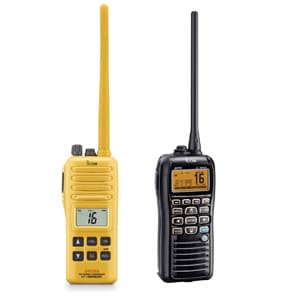 |
|
ICOM’s GM1600 VHF marine transceiver. |
Losing your floating castle is the worst fear you can face as an offshore sailor. And while we definitely want to make sure we have an EPIRB ready to send out a distress signal immediately, we also need some means of communicating with rescue operations should this unthinkable horror ever come to pass.
Packing a survival VHF radio in your vessel’s life raft is the best guarantee you will have of communicating with nearby ships. However, the ideal choice for this radio should include the ability to summon help beyond the typical eight-mile range of a hand-held VHF radio.
To begin, any submersible, floating, hand-held VHF will serve the purpose of an emergency radio on a life raft as long as the batteries hold out. One should use the radio sparingly, attempting contacts only if there is another vessel visible on the horizon. Desperate calls to nowhere by panicked crew, or the foolhardy attempt to monitor radio traffic constantly, will gradually drain the battery and decrease your chances of being found.
The question we should ask is whether it is advisable to spend approximately $600 on a GMDSS-rated hand-held that boasts long battery life and tough construction, or a less-expensive non-GMDSS-rated hand-held offering DSC and built-in GPS.
A piece of equipment stamped “GMDSS” (Global Maritime Distress and Safety) meets certain requirements for inclusion in a set of emergency equipment, particularly on commercial vessels. Cruising boats are not required to be GMDSS-equipped, so our choices of emergency equipment may be tailored to our own personal requirements.
ICOM’s GM1600 VHF marine transceiver offers the kind of tough construction demanded by the U.S. Coast Guard and international SOLAS (Safety of Life at Sea) regulations. Used on both commercial and pleasure vessels, the GM1600 is waterproof to 1 meter, and the lithium ion battery provides eight hours of operating time at temperatures ranging from -4° F to 140° F. The unit transmits at 1 or 2 Watts, which is lower than standard VHF hand-helds.
 |
|
The ICOM M92D DSC/GPS hand-held VHF radio. |
ICOM’s bright yellow emergency hand-held is intended for both emergency and routine communications. However, despite its durability, the GM1600 is a radio and nothing else, and a comparatively low-powered one at that.
Likewise, the ACR SR203 GMDSS Survival Radio offers only voice communications, but it does boast slightly higher output (2.5 Watts) and 16 hours of battery life. The radio comes complete with a replaceable lithium battery, rechargeable lithium polymer battery, rapid battery charger, power adapters and a wall mount.
For a significantly lower price, you can equip your vessel with an ICOM M92D DSC/GPS hand-held VHF radio, which allows you to transmit an emergency signal while you attend to the immediate matters of managing a lifeboat in rough seas.
The M92D includes a digital compass, waypoint storage, eight to 10 hours of battery life and a transmit power of 1 or 5 Watts, twice that of the SR203. A long list of separately sold accessories includes a cigarette lighter adapter, five battery options and a choice of three different microphones.
The one glaring shortcoming of the M92D as compared to the true emergency radios is its rating of “waterproof” rather than “submersible.” However, it floats, so as long as it is connected by a lanyard to either the life raft or a crewmember, you are guaranteed communication capability.
So, which is the better device if you end up stranded on a lifeboat, assuming an EPIRB has been activated? A tough, submersible, voice-only radio, or a waterproof DSC-capable radio with programmable GPS? It’s your call.

